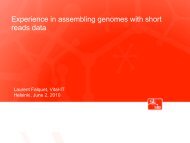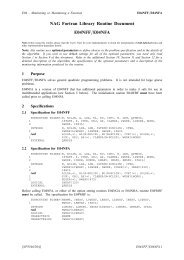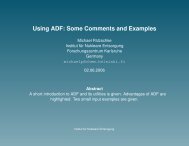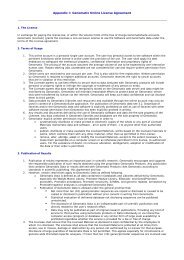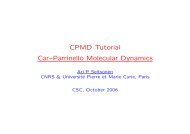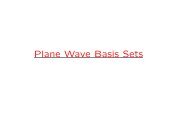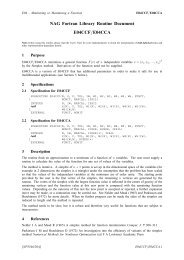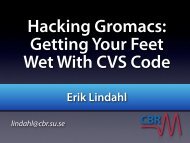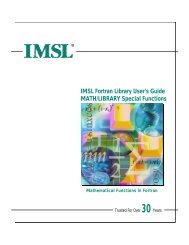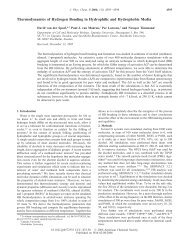Erik Lindahl
Erik Lindahl
Erik Lindahl
Create successful ePaper yourself
Turn your PDF publications into a flip-book with our unique Google optimized e-Paper software.
Simulations of<br />
Membranes &<br />
Membrane Proteins<br />
<strong>Erik</strong> <strong>Lindahl</strong><br />
lindahl@cbr.su.se<br />
CBR
Outline: Membranes<br />
• Why are membranes interesting/important<br />
• Lipids - amphiphilic molecules<br />
• Micelles, bilayers, vesicles, mixtures<br />
• Bilayer phases (crystal, gel, liquid crystalline)<br />
• Special difficulties for simulations<br />
• Bilayer simulations & typical systems<br />
• Membrane proteins, transmembrane helices<br />
• Membrane protein simulations
Importance of Membranes<br />
• Controls transport into/from cells<br />
• 30% of eukaryotic proteins are<br />
associated with membranes<br />
(membrane proteins, receptors)<br />
• 50% of current drugs<br />
target membrane proteins<br />
• “Without membranes you die”<br />
(David van der Spoel, 2007)
Lipids<br />
• Charged or strongly polar<br />
(zwitterionic) headgroups<br />
• 1-2 Hydrophobic chain(s)<br />
• Amphiphilic molecules<br />
• Typical headgroups:<br />
Phosphocholine (PC)<br />
Phosphoetanolamine (PE)<br />
• Glycerol link to acyl chain<br />
• Typical chains:<br />
Palmitoyl (16 CH2 groups)
Lipid names...<br />
• DPPC - Dipalmitoylphosphatidylcholine<br />
1,2-Dipalmitoyl-sn-Glycero-3-phosphocholine<br />
• DOPG - Dioleoylphosphatidylglycerol<br />
1,2-Dioleoyl-sn-Glycero-3-phosphoglycerol (negative charge!)<br />
• POPE - Palmitoyloleoylphosphatidyletanolamine<br />
1-Palmitoyl-2-Oleoyl-sn-Glycero-3-phosphoethanolamine<br />
• DPC - Dodecylphosphocholine<br />
(single chain only, forms micelles)<br />
• Cholesterol
Lipid conformations<br />
• Large headgroups, single chain:<br />
Lipids form micelles<br />
• Higher concentration:<br />
hexagonal phases<br />
• There are also inverted micelles<br />
and hexagonal phases<br />
• Similar size headgroup/chains:<br />
Bilayers or vesicles
Bilayer phases<br />
• Very low temperature: proper crystalline phase<br />
• low temperature: gel phase<br />
• room temperature: liquid crystalline phase (Lα)
Cellular membranes
A liquid crystalline bilayer
Lipid Bilayer analysis<br />
• Experimental techniques:<br />
Neutron scattering<br />
Liquid X-ray crystallography<br />
NMR, EPR, flourescence spectroscopy<br />
• Average area/lipid<br />
• Order parameters from spectroscopy<br />
• Electron density over the bilayer<br />
• Lipid diffusion<br />
• Average properties -> great statistics!
Bilayer simulations<br />
• Lipid parameters / force fields<br />
• Topologies<br />
• Getting initial conformations<br />
• Simulation cell shapes<br />
• Interaction parameters & setup<br />
• Pressure coupling<br />
• Center-of-mass motion
Lipid force fields<br />
• Groups: phosphate, choline, glycerol, acyl<br />
• Surprisingly hard to get accurate results<br />
• Many force fields lead to lipid area & volumes<br />
that are 20% lower than experimental values!<br />
• Do NOT use: Vanilla Gromacs FF, Gromos96,<br />
OPLS-AA/L, Amber, old Charmm FF<br />
• Do USE: Berger lipid force field, Charmm27<br />
• Berger is available on Gromacs site,<br />
Charmm27 in beta for Gromacs distributions
Lipid topologies<br />
• No bilayer coordinates in PDB<br />
• No standardized atom or chain names<br />
• pdb2gmx does not work automatically<br />
• Best option: Find existing topologies<br />
(Gromacs site, Tieleman, <strong>Lindahl</strong>, others)<br />
• Alternative 1: Create RTP building blocks<br />
• Alternative 2: Hack topologies manually
Example DPPC topology<br />
;Topology for united-atom DPPC<br />
;Written by <strong>Erik</strong> <strong>Lindahl</strong>, version 980624<br />
;After a gromos version by Olle Edholm<br />
; include our own forcefield - dont use gromacs parameters!<br />
;#include "ffDPPC.itp"<br />
[moleculetype]<br />
;Name nrexcl<br />
DPPC 3<br />
[atoms]<br />
; nr type resnr residu atom cgnr charge ; Chiu charges!<br />
1 C3N 1 DPPC CN1 1 0.16<br />
2 C3N 1 DPPC CN2 1 0.16<br />
3 C3N 1 DPPC CN3 1 0.16<br />
4 NL 1 DPPC NTM 1 0.26<br />
...<br />
17 CH2 1 DPPC C1B 6 -0.04<br />
18 CH2 1 DPPC C1C 7 0.0<br />
19 CH2 1 DPPC C1D 8 0.0<br />
20 CH2 1 DPPC C1E 9 0.0
Example DPPC topology<br />
...<br />
[ dihedrals ]<br />
; ai aj ak al funct (func=1 is normal dihedrals, 3=R-B)<br />
1 4 5 6 1<br />
4 5 6 7 1<br />
...<br />
17 18 19 20 3 ; R-B torsions for acyl chains<br />
18 19 20 21 3<br />
...<br />
[ system ]<br />
; Name<br />
DPPC membrane with 28 waters per lipid<br />
J. Chem. Phys., Vol. 115, No. 10, 8 September 2001 E. <strong>Lindahl</strong> and O. Edholm<br />
[ molecules ]<br />
; Compound #mols<br />
DPPC 64<br />
SOL 3000<br />
1,4 interactions excluded<br />
R-B/Kuwajima torsions<br />
FIG. 4. The scaling is justified by the very sensitive dependence of the<br />
dynamics on the effective dihedral potential. The factor 0.7 corresponds to<br />
only 0.9 kJ/mol probably below the model accuracy. The present work em-
United vs. all atom DPPC<br />
• 50 vs 130 atoms per lipid<br />
• 3x atom density in hydrophobic region<br />
• ~9x interaction density in hydrophobic region<br />
• Roughly 4-5x simulation speed difference
Bilayer structures<br />
• Find pre-equilibrated conformations<br />
• Ask authors of published papers<br />
(works great for Gromacs topologies too)<br />
• Use genbox & genconf to change system size<br />
• Repeat single lipid conformation on grid,<br />
equilibrate for a long time in vacuo<br />
• Repeat single lipid(s), add random rotation<br />
and tilts, shorter equilibration<br />
• Simulate bilayer formation ‘the natural way’
Membrane formation
Cell shapes<br />
• Rectangular membranes<br />
• Easiest option when the simulation goal<br />
is to calculate wave-vector dependent<br />
properties (undulations, etc.)
Cell shapes<br />
• Hexagonal membranes<br />
• Maximizes periodic separation distance<br />
• Can be viewed compact/triclinic/rectangular<br />
Compact<br />
Triclinic<br />
(actual periodicity)<br />
Rectangular & whole<br />
(default output)
Coulomb interactions<br />
• Very large dipoles & parts with low dielectric<br />
screening (hydrophobic core)<br />
• Cut-offs are bad<br />
• Reaction-field would assume an isotropic and<br />
homogeneous system (not the case)<br />
• Always use PME<br />
• PME works fine with triclinic cells in Gromacs
Van der Waals stuff<br />
• One reason for the difficulties in simulating<br />
membranes is the sensitivity to nonbonded<br />
Van der Waals parameters<br />
• Small changes will affect packing of chains,<br />
and thus the pressure and area/lipid<br />
• Normal cut-off or switch around 1.0nm is OK,<br />
but turn on long-range dispersion correction<br />
to get correct pressure
Pressure coupling<br />
• Two-dimensional liquid crystals<br />
• Bilayer should be able to deform in XY-plane<br />
• Anisotropic pressure coupling should be<br />
enabled throughout production runs!<br />
• Neat trick: Semiisotropic coupling (XY+Z)<br />
• Berendsen coupling does not provide a true<br />
NPT ensemble - Parinello-Rahman is better<br />
• Slow relaxation (10ps) to avoid oscillations
Compressibility<br />
• Water value works fine as approximation<br />
• Compressibility is really a 3x3 tensor<br />
Gromacs: 3 diagonal + 3 off-diagonal elements<br />
• Off-diagonal elements zero:<br />
only scale cell along the box vectors<br />
• Off-diagonal elements same as diagonal:<br />
Enable cell distortion/shear transformations<br />
• You can also force the cell to distort by setting<br />
off-diagonal reference pressure to non-zero
Thermostats<br />
• Polar and non-polar parts of the system are<br />
not always strongly coupled<br />
• Bond constraints remove kinetic energy:<br />
anisotropic temperature in acyl chains!<br />
• Use separate thermostats for water & lipids,<br />
and also protein(s) if present
Center-of-mass motion<br />
• Center-of-mass motion of<br />
entire system normally<br />
removed in simulations<br />
• Weak z-coupling in bilayers:<br />
• Water moves right, lipids left<br />
• Upper layer right, lower left<br />
• Remove center-of-mass<br />
motion separately for:<br />
water, upper layer, lower layer<br />
comm_grps = upper lower SOL
Lipid diffusion<br />
• Frequently overestimated by an order<br />
of magnitude due to layer c-o-m motion!<br />
• Can be corrected after simulations too, though<br />
J. Chem. Phys., Vol. 115, No. 10, 8 September 2001 NMR relaxation in lipid bilayers<br />
4943<br />
vesicle tumbling or collective effects. We have derived analytical<br />
corrections for these contributions in appendix A, but<br />
none of the alternatives produce an asymptotic 1/ behavior.<br />
The proposed frequency dependence thus seems to be a<br />
good phenomenological model for the relatively limited frequency<br />
range covered by NMR experiments and mainly<br />
caused by the nonexponential relaxation from chain isomerization,<br />
but it would be quite puzzling if it persists to much<br />
lower frequencies in future measurements. In the opposite<br />
limit of high frequencies, simulations can access much<br />
higher regions than NMR experiments. Since the decay of<br />
the correlation function is strongly nonexponential even at<br />
short times, the calculated NMR relaxation rate does not approach<br />
a finite nonzero value in the limit of very high frequencies.<br />
On the contrary, it continues to zero.<br />
10 ns 100 ns MSD (10x slower than H2O)<br />
B. Lipid translational & reorientational diffusion<br />
FIG. 5. Center-of-mass mean square displacement of the lipids solid and<br />
the linear regression dashed. The inset shows probability distributions of<br />
one-dimensional displacements, i.e., diffusion propagators, for motions over
Electron density<br />
• g_density<br />
You need to provide electrons.dat with<br />
4.1. Composition & Structure 41<br />
number of electrons/atom, see -h flag.<br />
500<br />
Electron density (nm -3 )<br />
400<br />
300<br />
200<br />
100<br />
-3 -2 -1 0 1 2 3<br />
Distance from bilayer center (nm)
Order parameters<br />
• g_order (requires index file with i-1, i+1)<br />
S CD = 3〈 cos 2 θ 〉 − 1<br />
42 Chapter 4. Membranes<br />
2<br />
-0.3<br />
S CD<br />
-0.2<br />
i-1<br />
i<br />
C<br />
H(D)<br />
-0.1<br />
i+1<br />
5 10 15<br />
Carbon atom<br />
Figure 4.3. Order parameters for the C–H vectors (experimentally C–D) in the lipid
Undulations<br />
• Assign lipid z-coordinates to a grid<br />
• Perform 2D Fourier transforms<br />
• Plot amplitides vs. wave vector magnitude
Example: cholesterol<br />
(Cells can control membrane stiffness with cholesterol)
Undulations<br />
A<br />
B<br />
10 -2<br />
intensity (nm 2 )<br />
10 -3<br />
10 -4<br />
Collective<br />
Membrane Motion<br />
Single<br />
Lipid Motion<br />
2<br />
0.5 1.0 5<br />
wavenumber (nm -1 )
Membrane proteins<br />
• Prepare structure<br />
without membrane<br />
• Solvate protein in bilayer,<br />
e.g. with genbox<br />
• Add solvent water<br />
• Freeze protein for relaxation<br />
freezegrps = protein<br />
freezedim = y y y<br />
• Avoid water entering between<br />
lipids and protein by restraining<br />
the water z coordinates
Water restraints<br />
• Open the topology in a text file, and after the<br />
water #include line add<br />
; Position restraint for each water oxygen<br />
[ position_restraints ]<br />
; i funct fcx fcy fcz<br />
1 1 0 0 1000<br />
• Waters are free in XY-plane, but z-restrained<br />
• Works for lipids too in really bad system<br />
• Equlibrate lipids ~10ns, then water too<br />
• If water enters the membrane, remove it<br />
• Multiple equilibration cycles can be necessary
Mixed lipid & protein FFs<br />
• Berger force field does not include proteins<br />
However: Based on OPLS, so it mixes nicely<br />
with OPLS-AA/L (all-atom) for proteins!<br />
• Charmm27 OK too (but 4-5x more expensive)<br />
• Pure Gromos96, OPLS-AA/L, Amber, etc:<br />
constrain cell dimensions for reasonable lipid<br />
density & area - can still be OK if lipids are<br />
mainly passive solvent for your protein
United vs. All-atom - 1<br />
• The Berger force field performs equally well,<br />
if not better, compared to Charmm27<br />
• Hydrogens on chains only have low charge<br />
No net charge - extremely weak dipoles!<br />
• In principle the weak dipoles could aid the<br />
solvation of polar/charged groups<br />
• However, in practice the Berger force field<br />
mixed with OPLS-AA reproduce these<br />
experimental values very well too!
Bilayer solvation<br />
in vivo hydrophobicity (kcal/mol)<br />
3<br />
2<br />
1<br />
0<br />
D<br />
K<br />
E<br />
R<br />
P<br />
Q<br />
N<br />
H<br />
T<br />
W<br />
S<br />
Y<br />
A M<br />
L I C<br />
V F<br />
0 1 2 3<br />
This work (kcal/mol)<br />
If anything, the<br />
solvation cost<br />
is slightly low<br />
compared to<br />
in vivo values!
United vs. All-atom - 2<br />
• Nothing wrong with all-atom force fields<br />
• For proteins in water the difference is<br />
negligible<br />
• But not for membranes - significant<br />
performace boost with united atom model<br />
• “Proof is in the pudding”<br />
• Hard to justify 4x increased cost without any<br />
indication the results would be better<br />
• Sampling still worse issue than FF details!
Summary<br />
• Easier than proteins: 256-1024 lipids provide<br />
way better statistics<br />
• Harder than proteins: Quite sensitive to force<br />
field details, less work done<br />
• Very slow processes (>100ns)<br />
• Interesting non-equilibrium biology: ion<br />
transport, insertion, vesicle formation, etc.<br />
• Membranes scale great (>1000 CPUs in CVS)



